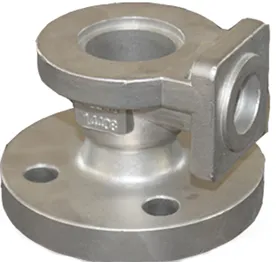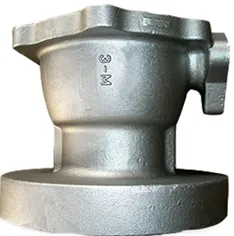Mobile:+86-311-808-126-83
E-mail:info@ydcastings.com
Understanding the Valve Body: A Key Component in Fluid Control Systems
IL corpo valvola is a central element in a wide range of fluid control systems, playing a critical role in the regulation, isolation, and distribution of fluids within pipelines. Whether in industrial processes, plumbing systems, or heavy-duty machinery, the valve body ensures that fluids are directed through systems with precision and safety. This article delves into the importance of valve bodies, their design features, materials, and applications, illustrating how these components are fundamental to the efficient operation of various industries.

What Is a Valve Body and Why Is It Important?
At its core, a valve body castings is the main structural component of a valve, housing the internal parts, including the stem, actuator, seals, and sometimes a ball or disk. It acts as the conduit for fluids (such as water, gas, steam, or oil) and directs their flow through the system by manipulating the internal mechanisms. The valve body’s role is essential because it determines how well the valve can control the flow of fluids in both open and closed positions.
In essence, the valve body controls the pressure, volume, and direction of fluids, making it a critical part of systems that require precise fluid management. Depending on the type of valve, such as ball, gate, globe, or check valves, the body’s design will vary to accommodate the specific internal components and functionality needed for fluid regulation.
Key Design Features of a Valve Body
The design of a valve body is determined by several factors, including the type of valve it will house, the materials of construction, and the operating environment. The shape and size of a valve body vary depending on the type of valve, but typically, the valve body is cylindrical, square, or rectangular in shape to suit the associated pipeline.
The valve body is often designed with an inlet and outlet port to allow fluid to enter and exit. In addition, it incorporates passages or chambers where the valve's internal parts (like the ball, disk, or plug) can interact with the fluid to either stop, regulate, or allow its flow. Seals and gaskets are often used around these passages to prevent leakage and ensure the valve operates efficiently under pressure.
For example, in a ball valve, the body will contain a spherical ball with a hole through the center that rotates to control the flow of the fluid. In a gate valve, the body houses a sliding gate or wedge mechanism that lifts or lowers to open or close the flow passage.
Another essential design feature is the inclusion of flanges or threaded connections on the valve body, which allow the valve to be securely fastened to the piping system. These connections ensure that the valve body can be installed and maintained without compromising the integrity of the pipeline.

Materials Used in Valve Body Construction
The material selection for a valve body is critical, as it must be durable enough to handle the specific fluid pressures, temperatures, and chemical environments the valve will be exposed to. The choice of material also affects the valve’s lifespan, ease of maintenance, and cost-effectiveness.
Common materials used for valve bodies include:
Cast Iron: Often used in lower-pressure systems, cast iron is a cost-effective material that provides good strength and durability. However, it may not be suitable for high-pressure or highly corrosive environments.
Steel (Carbon and Stainless): Carbon steel and stainless steel are commonly used in valve bodies because of their excellent strength, resistance to wear, and ability to withstand high temperatures and pressures. Stainless steel, in particular, is highly resistant to corrosion, making it ideal for use in chemical processing and marine applications.
Brass and Bronze: For smaller valves or applications requiring corrosion resistance without the need for high strength, brass and bronze are used. These materials are common in plumbing systems and other low-pressure fluid control applications.
Alloys and Composites: In high-performance applications, such as in the aerospace or petrochemical industries, valve bodies may be made from special alloys or composites. These materials offer superior resistance to extreme temperatures, pressure, and corrosion, ensuring the valve body maintains its structural integrity in demanding environments.
Each material has its advantages and trade-offs. For instance, while stainless steel provides excellent corrosion resistance, it may be more expensive than cast iron. Conversely, cast iron may be less expensive but might not perform well under high-temperature or high-pressure conditions. The choice of material must, therefore, align with the specific requirements of the system in which the valve will be used.
Applications of Valve Bodies
Valve bodies are integral to a broad range of industries, with applications that span from residential plumbing systems to large-scale industrial operations. In residential plumbing, valve bodies are used in faucets, shut-off valves, and water regulators, where they control the flow of water to various parts of a home.
In industrial and commercial settings, valve bodies are critical components in manufacturing, chemical processing, power plants, oil and gas pipelines, and water treatment facilities. These valves control the flow of essential fluids, such as steam, water, oil, or gas, often under high-pressure or high-temperature conditions. For example, in power plants, valve bodies regulate steam flow to turbines, while in the oil and gas industry, they control the flow of crude oil or gas through pipelines.
In the automotive industry, valve bodies are found in components such as transmission systems, where they regulate fluid flow to control the vehicle’s shifting patterns. The aerospace industry also relies on valve bodies to manage fluid flows in aircraft hydraulic systems.
-
Materials Used in Manufacturing Cap End Pipe FittingsNotiziaNov.24,2025
-
Material Properties of CF8M CastingNotiziaNov.24,2025
-
How to Inspect Pump Cap Ends for DamageNotiziaNov.21,2025
-
Backward Curved Impeller – Efficient Airflow Solutions for Industry | YD CastingsNotiziaNov.21,2025
-
Automobile Water Pump - Efficient, Quiet, Durable & ElectricNotiziaNov.21,2025
-
Impeller for Pumps – High-Efficiency, Durable, OEM-ReadyNotiziaNov.21,2025











